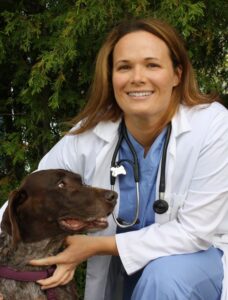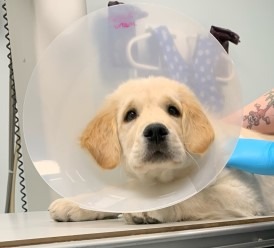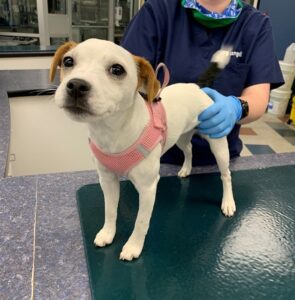-
Adopt
-
Veterinary Care
Services
Client Information
- What to Expect – Angell Boston
- Client Rights and Responsibilities
- Payments / Financial Assistance
- Pharmacy
- Client Policies
- Our Doctors
- Grief Support / Counseling
- Directions and Parking
- Helpful “How-to” Pet Care
Online Payments
Referrals
- Referral Forms/Contact
- Direct Connect
- Referring Veterinarian Portal
- Clinical Articles
- Partners in Care Newsletter
CE, Internships & Alumni Info
CE Seminar Schedule
Emergency: Boston
Emergency: Waltham
Poison Control Hotline
-
Programs & Resources
- Careers
-
Donate Now
 By Amanda Lohin, DVM
By Amanda Lohin, DVM![]()
angell.org/emergency
781-902-8400
Any dog owner knows that dogs are generally curious creatures, who love to explore with their mouths. It is not at all uncommon for dogs to eat things that can harm them, including foreign objects, medications, toxins, or even some types of human foods. So, what should you as an owner do if you think your dog has ingested something that could harm them? The first thing you should do is call your veterinarian’s office or an emergency veterinary hospital for advice. From there, you may be instructed to bring your pet in to be seen, call poison control, or just monitor at home. Animal poison control centers, like the ASPCA poison control, have veterinarians and toxicologists with extensive information about ingredients in different toxic substances, as well as toxic doses and treatment recommendations, which is valuable information for your veterinarian to have in order to provide the best treatment for your pet.
 For most toxin ingestions, there is a general decontamination protocol, although this can vary depending on the toxin. The veterinarian seeing your dog will start with a physical exam, which will allow them to assess for any abnormalities that could be resulting from the toxin ingestion. After examining your pet, the veterinarian will consult with animal poison control using the case number given to you when you call. If indicated, vomiting will be induced to try to get any remaining toxin out of the stomach (depending on time frame from ingestion). There are certain situations where inducing vomiting may be contraindicated or have increased risk due to the toxin ingested, breed of dog or some pre-existing conditions. Some toxic ingestions require hospitalization with close monitoring, while others can be easily treated as an outpatient.
For most toxin ingestions, there is a general decontamination protocol, although this can vary depending on the toxin. The veterinarian seeing your dog will start with a physical exam, which will allow them to assess for any abnormalities that could be resulting from the toxin ingestion. After examining your pet, the veterinarian will consult with animal poison control using the case number given to you when you call. If indicated, vomiting will be induced to try to get any remaining toxin out of the stomach (depending on time frame from ingestion). There are certain situations where inducing vomiting may be contraindicated or have increased risk due to the toxin ingested, breed of dog or some pre-existing conditions. Some toxic ingestions require hospitalization with close monitoring, while others can be easily treated as an outpatient.
Dogs who ingest foreign material usually require very different treatment from those who ingest toxic substances. If you actually SEE your pet ingest something foreign and seek help immediately, depending on what was ingested, sometimes vomiting can be induced to bring the object back up, therefore avoiding the risk of an obstruction. However, most of the time, owners are not aware that their pet has ingested a piece of a toy, sock, underwear, or even a large amount of organic material (i.e. plant material). The most common presentation for a foreign body obstruction is a dog that has been progressively vomiting and/or regurgitating, lethargic and not eating. Physical exam usually reveals some degree of dehydration, sometimes tachycardia (fast heart rate), nausea and abdominal pain. For these pets, blood work and abdominal radiographs (x-rays) are indicated to assess hydration status and look for signs of an obstruction. Sometimes chest radiographs are also indicated if there is concern for an esophageal foreign body or aspiration pneumonia from vomiting and/or regurgitation.
If foreign material is identified in the stomach only, but inducing vomiting is either not successful or not safe, options for removal can include endoscopy or surgical gastrotomy. Endoscopy is a procedure where, under general anesthesia, a camera can be directed down the esophagus and foreign material retrieved from the gastrointestinal tract with a small clamp. This procedure can be a successful way to avoid surgery with the right kind of foreign material, but objects that are not safe to pull back through the esophagus or are too friable or slippery for the endoscopy clamp to be able to grasp will require surgical removal. A gastrotomy is generally a quick surgical procedure where the stomach is opened, emptied and sutured closed, followed by a thorough flush of the abdomen.
 Alternatively, if radiographs indicate that foreign material is present in both the stomach and small intestines, or if an obstructive pattern is noted on radiographs, surgical explore is indicated. When there is a small intestinal obstruction, due to the smaller diameter lumen of the intestines compared to the stomach, there is a much greater risk for tissue damage, which may require resection of some tissue that is no longer viable. Small intestinal obstructions if caught early can often be removed with a simple enterotomy (single incision into the intestine). Obstructions that are present for a longer time prior to diagnosis often cause greater tissue damage and can result in the need for a procedure called “resection and anastomosis,” where part of the intestine is removed and the two healthy ends are brought together to heal. If not treated at all, a foreign body obstruction will ultimately lead to perforation of the gastrointestinal tract, sepsis and death.
Alternatively, if radiographs indicate that foreign material is present in both the stomach and small intestines, or if an obstructive pattern is noted on radiographs, surgical explore is indicated. When there is a small intestinal obstruction, due to the smaller diameter lumen of the intestines compared to the stomach, there is a much greater risk for tissue damage, which may require resection of some tissue that is no longer viable. Small intestinal obstructions if caught early can often be removed with a simple enterotomy (single incision into the intestine). Obstructions that are present for a longer time prior to diagnosis often cause greater tissue damage and can result in the need for a procedure called “resection and anastomosis,” where part of the intestine is removed and the two healthy ends are brought together to heal. If not treated at all, a foreign body obstruction will ultimately lead to perforation of the gastrointestinal tract, sepsis and death.
Most pets who have an uncomplicated foreign body surgery are in the hospital for 2-3 days. Prior to discharge, it is important that they are eating well and their pain is well controlled on oral medications. More complicated surgeries can include those where the gastrointestinal tract has perforated causing a septic abdomen, or dogs who develop aspiration pneumonia from their excessive vomiting or regurgitation. When such complications arise, the duration of hospitalization can vary from several days to sometimes over a week before they are stable to go home. Once home, your pet will likely be on several medications for nausea, pain, sometimes diarrhea medication, an appetite stimulant, antibiotics and usually a bland diet. The abdominal sutures or staples are left in place for 10-14 days prior to removal. As an owner caring for a dog who has just had surgery for a foreign body obstruction, it is important to ensure they are taking their medications as instructed and until gone. It is VERY important that they wear their Elizabethan collar (lamp shade collar) at all times to prevent them from licking the incision, which can lead to infection or dehiscence (opening of the incision due to failure of the sutures); both of these situations can necessitate an incision revision surgery. The owner should check the incision daily for redness, swelling, discharge or pain on gentle palpation and notify their veterinarian if any of these are observed. Additionally, if the pet becomes lethargic, stops eating, or develops vomiting after returning home, a veterinarian should be consulted.
This article is meant to give a general idea of how certain ingestions need to be treated and what to potentially expect when a pet ingests something it should not. However, the general take home message is that if you are unsure if it is a problem, it is always best to call your veterinarian’s office to get their advice on whether or not it is necessary to seek treatment. In a perfect world, these are situations we would like to avoid all together, as trips to the ER or your primary care veterinarian when your dog has ingested something can be stressful for your dog, and both stressful and expensive for you as an owner. The best way to avoid these situations is to be vigilant about ensuring that any human medications or toxic substances are always kept well out of reach, not in a purse or suitcase on the floor or on the bathroom counter, and examine your pet’s toys on a regular basis. Any toys that have been destroyed and have loose stuffing and squeakers, or bones that have been chewed to the size where they could now accidentally be swallowed whole should be thrown away. Taking these simple steps on a regular basis to “dog-proof” your home can help to avoid a potentially life threatening situation for your beloved pup.